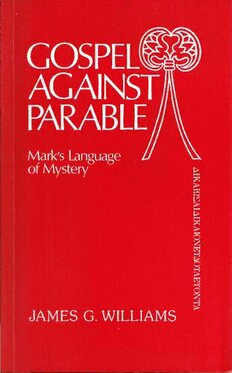Table Of ContentGOSPEL
AGAINST
PARABLE
Mark's Language
of Mystery
JAMES G. WILLIAMS
ALMOND • 1985
BIBLE AND LITERATURE SERIES, 12
Library of Congress Cataloging in Publication Data:
Williams, James G., 1936-
Gospel against Parable.
(Bible and literature series, ISSN 0260-4493; 12)
Bibliography: p.
Includes index.
1. Bible. N.T. Mark--Criticism, interpretation,
etc. 1. Title. II. Series
BS2685.2. W66 1986 226' .3066 85-18684
ISBN 0-907459-44-7
ISBN 0-907459-45-5 (pbk.)
Copyright © 1985 JSOT Press
ALMOND is an imprint of
JSOT PRESS
Department of Biblical Studies
The University of Sheffield
Sheffield, S10 2TN, England
Origination & Editorial:
THE ALMOND PRESS
Columbia Theological Seminary
P.O. Box 520
Decatur, GA 30031, U.S.A.
Printed in Great Britain by
Dotesios (Printers) Ltd.
Bradford-on-Avon, Wiltshire
CONTENTS
AKNOWLEDGEMENTS 7
INTRODUCTION 9
Chapter I
LITERARY CHARACTER
OF THE GOSPEL OF MARK 23
A. Mark and Oral Tradition 26
B. Mark's Plot 28
C. III What Sense is Mark 'Historical'? 29
Chapter II
SECRET OF THE SON 41
A. The Mystery of the Kingdom of God 41
B. The Mystery and the Disciples 55
Chapter III
MARK'S LANGUAGE OF MYSTERY 65
A. Style 66
1. Abruptness, Discontinuity, Enigma 66
2. Parataxis and Rapidity 74
3. Repetition 83
B. The Coming 91
1. The Onrush of the Kingdom 91
2. The Way of the Kingdom 97
3. Participation in God's Future 104
C. The Presence 112
1. Sea and Boat 114
2. Bread in the Wilderness 120
3. The Ultimate Parable of Presence 126
D. Summary and Conclusion 130
_§!!!§!j!§!ii§!i!§!ii§J
